Introduction
Different projects come with very different material and precision requirements in production. Heavy or oversized materials like wood and acrylic must be well-supported and ventilated to ensure clean cuts, whereas thin or irregular pieces need a platform that adapts to their shape to prevent warping. Single-platform laser machines often struggle to meet both needs efficiently.
Titan industrial-grade laser engravers tackle this challenge with a dual laser work table design. By combining these the honeycomb table and the knife-blade table, Titan delivers unmatched versatility, allowing professional users to switch between materials and project types without sacrificing precision or efficiency.
Contents
1. Honeycomb Table with Vacuum Adsorption
The honeycomb table—named for its hexagonal, honeycomb-like pattern—has long been the go-to work platform for a wide range of materials and project sizes. Its honeycomb structure provides stable, evenly distributed support while allowing smoke and debris to escape through the open cells, which helps maintain clean cutting edges and reduces burn marks on the underside of the material.
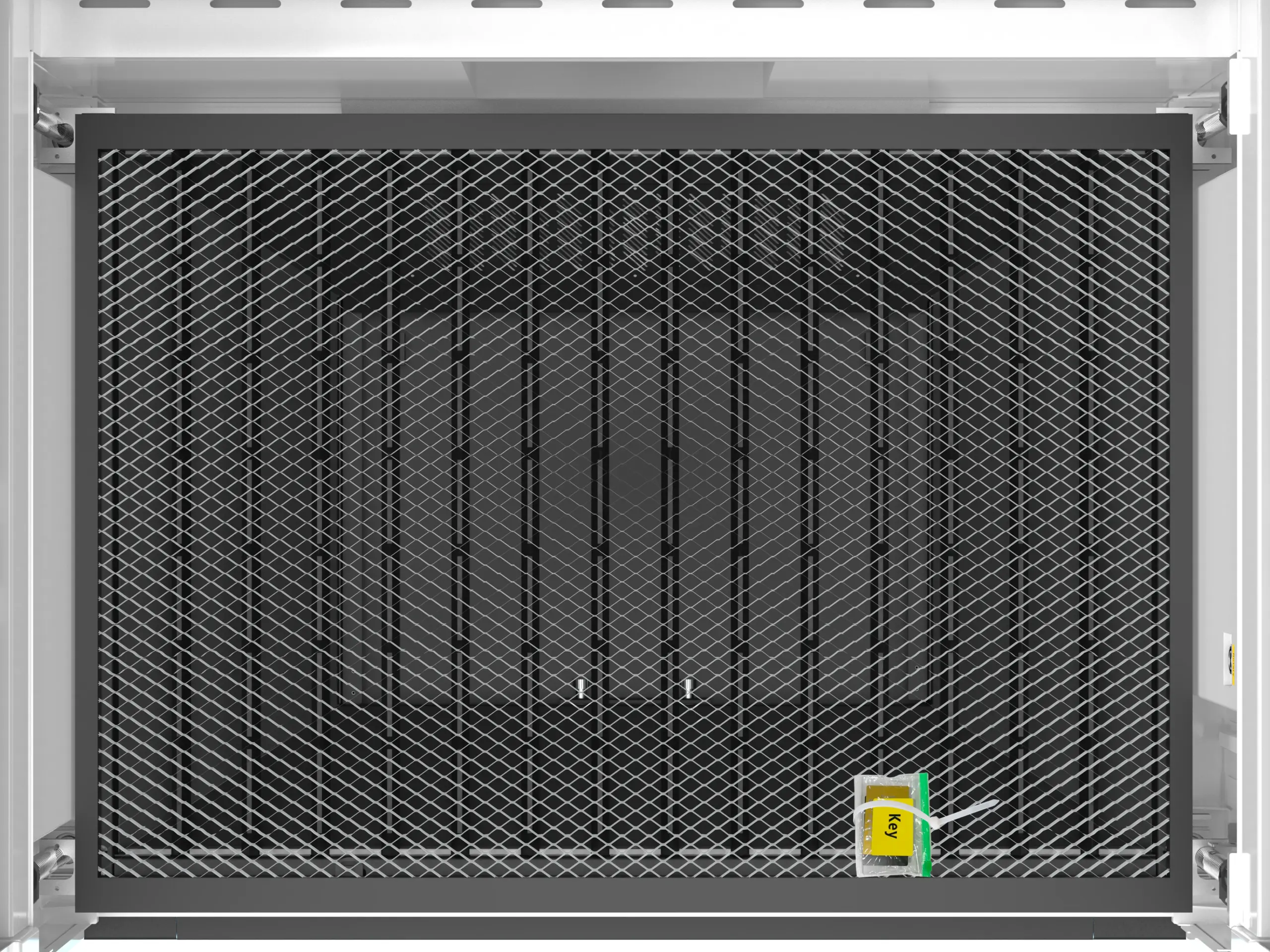
The honeycomb table is particularly effective for thin or delicate sheets because its hexagonal pattern creates numerous small openings that act as stable support points. These openings allow operators to secure materials using pins or magnets, preventing movement and ensuring a flat, even surface during engraving and cutting.

On Titan machines, the honeycomb platform goes one step further with an integrated vacuum adsorption system. By creating a pressure difference, the vacuum system holds materials firmly against the table, ensuring an exceptionally flat and stable working surface. This capability is especially valuable for ultra-lightweight, thin, or soft materials such as films, veneers, or paper, where even slight movement could compromise engraving precision. The vacuum system, working together with the honneycomb table, unlocks new levels of accuracy and reliability for high-precision processing tasks.
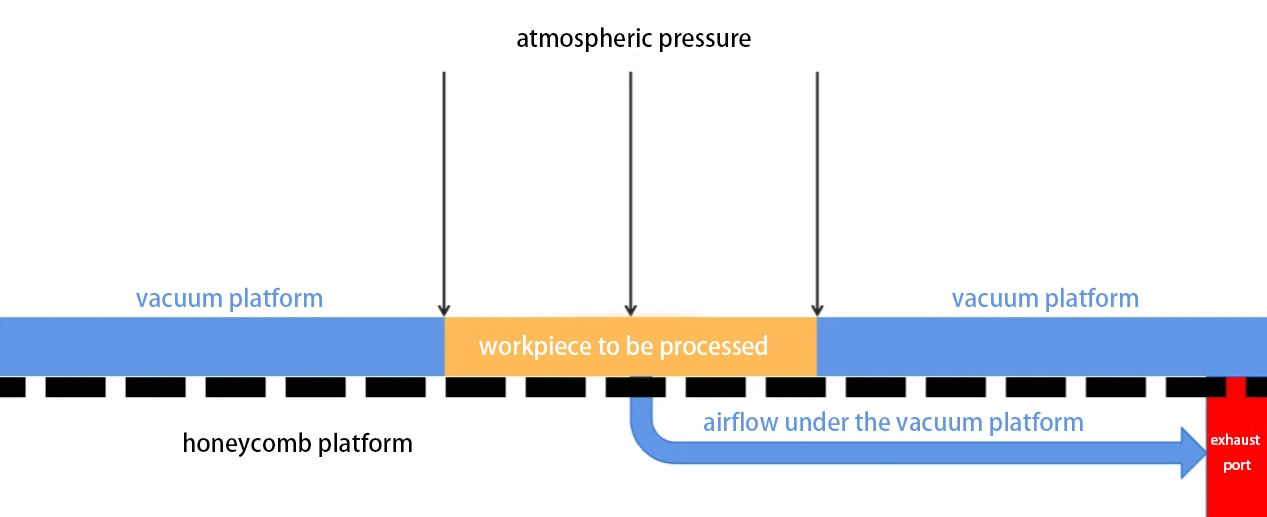
While the honeycomb table works well for thin or small materials, its design can become a limitation when processing thicker or heavier materials. Because the material rests over a larger contact area, airflow through the openings can be restricted, causing smoke and heat to accumulate beneath the workpiece. This can lead to inconsistent cutting quality or unwanted burn marks.
Learn more: Disassembly and Installation of Laser Honeycomb Table
2. Knife-Blade Table with Low Reflection
For processing thicker or larger materials, such as solid wood or acrylic sheets, the knife-blade table offers a specialized solution. Unlike the honeycomb table, the knife-blade table consists of multiple parallel aluminum slats or “blades”, which not only provide minimal contact points but also take advantage of aluminum’s excellent thermal conductivity. This design allows heat to dissipate efficiently, reduces smoke and heat accumulation beneath the workpiece, improving airflow and preventing unwanted burn marks at the bottom of the cut.
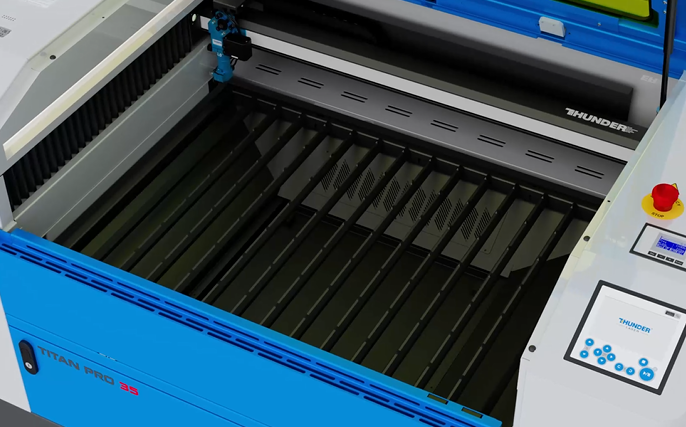
A key feature of the knife-blade table is its adjustable blades, which are secured in dedicated slots. Individual blades can be removed for easy cleaning or to accommodate irregularly shaped workpieces, enhancing flexibility in industrial production. When properly secured, the aluminum slats provide stable support for heavier or larger panels, reducing the risk of material warping during cutting.
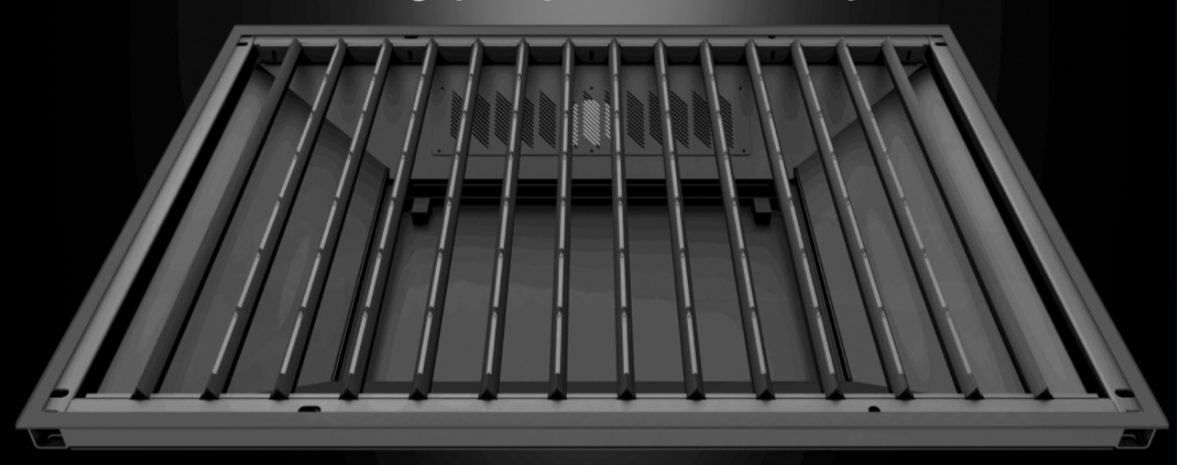
Beyond stable support, the knife-blade design also improves cutting results in two important ways. First, by minimizing the surface contact between the material and the platform, it reduces unwanted laser reflections from the underside of the workpiece, which can otherwise affect engraving quality or cause minor scorching. Second, the secure, segmented slats help dampen vibrations during cutting, ensuring smoother, more precise edges. Together, these features enhance the overall consistency, accuracy, and visual quality of the finished product.
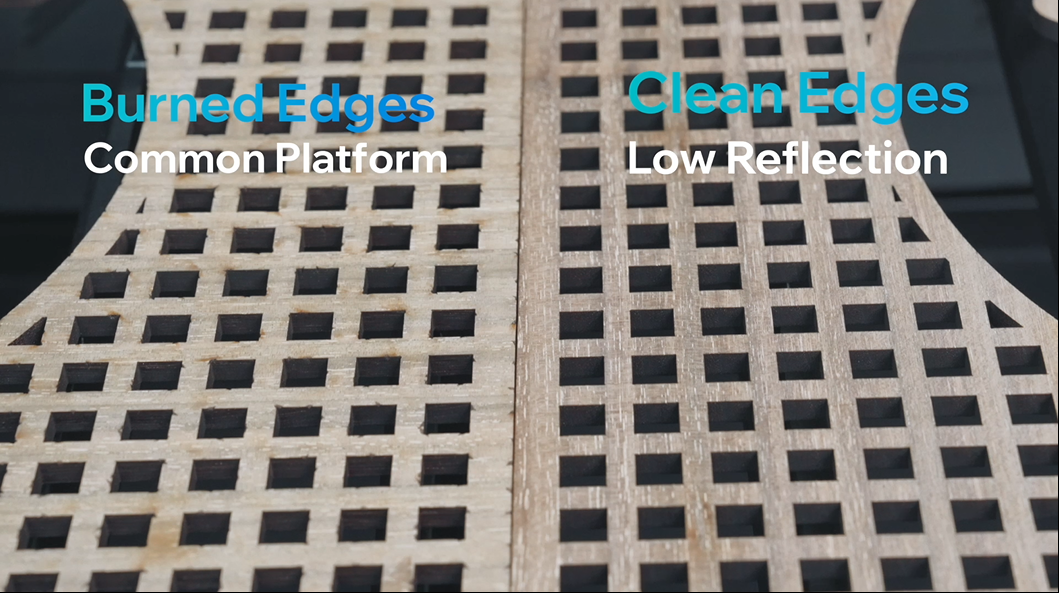
While the knife-blade table excels with heavier or larger panels, it is less convenient for securing small or delicate pieces, since it offers fewer natural support points compared to the honeycomb table. This makes it ideal as a complementary platform in combination with the honeycomb table, allowing operators to choose the most suitable work surface for the material and project at hand.
By incorporating these two laser work tables, Titan industrial-grade laser engravers provide unmatched versatility, enabling professional users to handle a wide range of material types and thicknesses without compromising precision, safety, or efficiency.
| Feature | Honeycomb Table | Knife-Blade Table |
|---|---|---|
| Structure | Hexagonal openings | Aluminum slats |
| Core Advantage | Vacuum adsorption keeps thin sheets flat | Low-reflection aluminum slats improve cut quality |
| Material Contact | Multiple points | Minimal points |
| Best For | Thin / delicate sheets | Thick / heavy panels |
| Support | Pins / magnets | No |
| Thermal / Burn Control | Good | Better |
| Vibration | A few | Less |
| Flexibility | Supports various materials | Supports thick / heavy materials |
| Limitations | Heavy materials; limited airflow | Less convenient for small/thin sheets |
Honeycomb Table vs. Knife-Blade Table
Learn more: Getting started Tips and Tricks for laser cutting
3. Choosing the Right Platform for Your Project
Selecting the most suitable work platform for your laser engraving project is essential for achieving high-quality results, efficient workflow, and consistent precision. With Titan, this decision becomes easier, because the machine comes equipped with two laser work table, both a vacuum-enhanced honeycomb table and a low-reflection knife-blade table. Operators no longer need to choose between platforms—the Titan provides the right solution for every material type, thickness, and workpiece size.
3.1 Honeycomb Table for Engraving and Lightweight Sheets
The honeycomb table on Titan, enhanced with a vacuum adsorption system, is best suited for engraving and processing lightweight or flexible sheets. This setup ensures that thin materials such as paper, veneer, and films remain flat and stable, making it ideal for high-precision applications or large-batch engraving jobs.
3.2 Honeycomb with Pin Support for Uneven or Thin Panels
Thin acrylic, plywood, or other lightweight sheets often require extra care to stay flat during cutting. Titan‘s honeycomb table supports these materials evenly while allowing the use of pins or magnets to hold them securely in place. This prevents movement, warping, or misalignment, which are common issues when processing delicate or uneven workpieces. Operators can choose from T-shaped, L-shaped, or F-shaped pins depending on the project needs—F-shaped pins, for example, are particularly useful for clamping plywood tightly and avoiding burn marks along the cut edge.
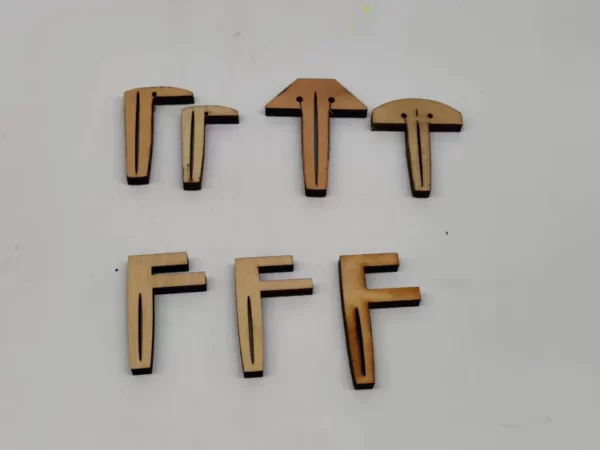
3.3 Cut Thick Materials with Knife–blade Table
For flat, rigid, and thick materials, Titan’s knife-blade platform delivers unmatched performance. Its aluminum slats are engineered with low-reflection properties, which prevent unwanted laser bounce-back from damaging the underside of the workpiece. This is particularly valuable for:
● Acrylic cutting – achieving crystal-clear edges without secondary marks.
● Thick wood boards – maintaining clean surfaces without charring underneath.
● High-power cutting jobs – avoiding reflection damage to both material and machine optics.
Beyond preventing reflections, the knife-blade design keeps heavy panels stable, making it the professional choice for large signage production, furniture panels, or architectural acrylic models where both thickness and finish quality matter.
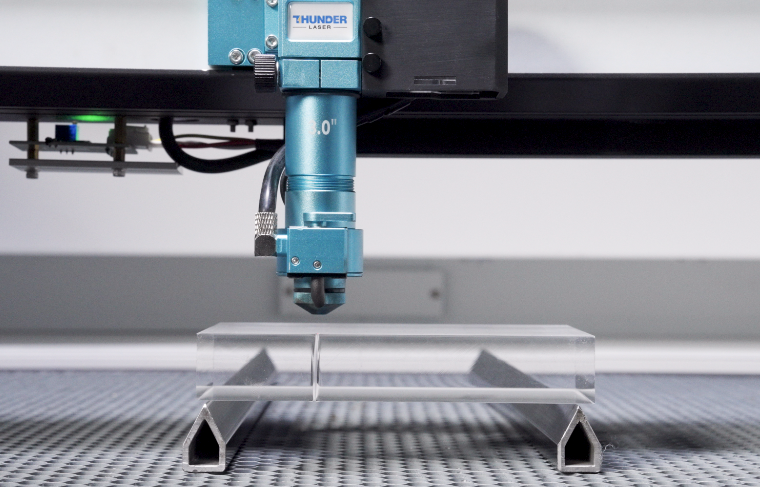
Conclusion
Equipped with both a honeycomb table and a knife-blade table, the Titan Series is built to meet the diverse demands of industrial production. Instead of forcing operators to compromise between platforms, Titan provides the flexibility to process thin, irregular sheets with secure positioning on the honeycomb surface, while also delivering superior performance on thick, heavy, and flat panels with the knife-blade design.
Dual laser work tables not only enhances cutting precision and material adaptability but also streamlines workflow by allowing users to switch seamlessly between project types. For manufacturers and professionals, Titan’s design translates into cleaner results, higher efficiency, and greater confidence in tackling any production challenge.
Why does You need both a honeycomb table and a knife-blade table?
Different materials require different support. The honeycomb table is best for thin or irregular sheets that need pins or magnets for secure positioning, while the knife-blade table is ideal for thick and flat panels like wood or acrylic. Titan combines both to handle a wider range of applications without compromise.
Can I switch between Titan's two laser work tables easily?
Yes. Titan’s modular design allows operators to change laser work tables quickly, ensuring smooth transitions between projects and minimizing downtime in production.
What materials benefit most from the honeycomb table?
The honeycomb table works well with lightweight materials such as thin wood, acrylic, paper, or fabrics. Its open-cell structure also allows the use of pins or magnets to secure uneven or flexible sheets.
What are the main advantages of the knife-blade table?
The aluminum slats provide stable support for heavy or flat panels, improve heat dissipation, reduce burn marks, and minimize vibration during cutting—leading to smoother edges and cleaner results.


.png) International
International
 United States
United States
 Brasil
Brasil
 Canada
Canada
 Costa Rica
Costa Rica
 Mexico
Mexico
 Česká
Česká
 Romania
Romania
 Polska
Polska
 Ireland
Ireland
 Portugal
Portugal
 Lietuva
Lietuva
 Россия
Россия Deutschland
Deutschland
 Britain
Britain
 Україна
Україна
 France
France
 Sverige
Sverige
 Italia
Italia
 Norway
Norway
 Denmark
Denmark
 Ελλάδα
Ελλάδα
 한국
한국
 中国
中国
 ประเทศไทย
ประเทศไทย
 中国香港
中国香港
 Israel
Israel
 中國臺灣
中國臺灣
 India
India
 پاکستان
پاکستان
 پශ්රී ලංකා
پශ්රී ලංකා
 ジャパン
ジャパン
 Australia
Australia
 New Zealand
New Zealand
 South Africa
South Africa